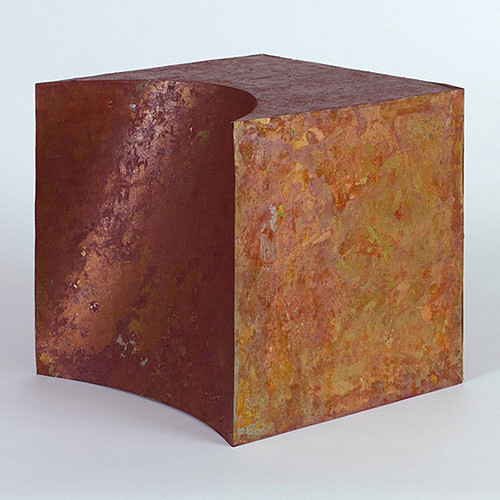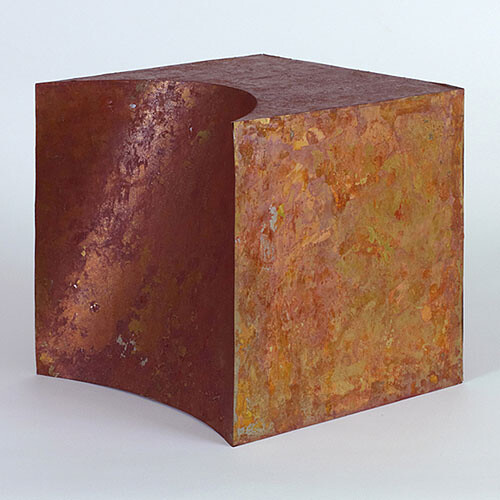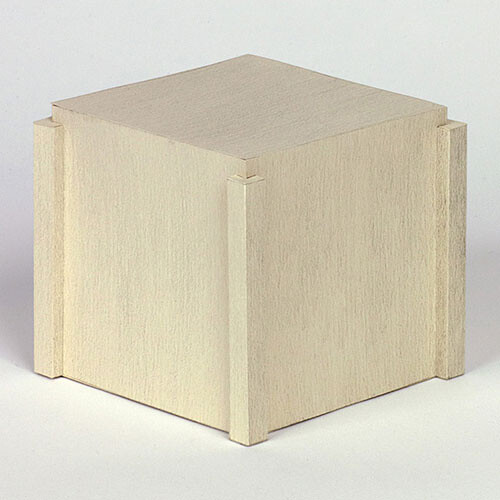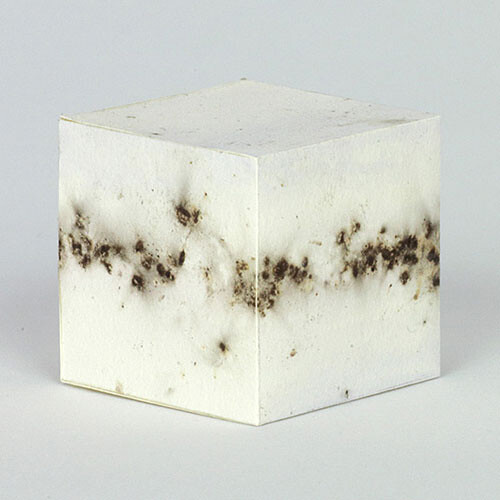Michael Wang’s recent one-week exhibition, “Carbon Copies,” had nothing to do with those antiquated, inky sheets necessary before the advent of more efficient means of reproduction. For one thing, Wang’s work was nowhere near as messy. A trained architect, he used his first solo exhibition to “copy” twenty contemporary artworks from the perspective of their environmental impact. The show was tightly focused, neatly presented, grounded in persuasive research, and—in some way—entirely superfluous to his project’s stated aims.
His setup was straightforward, if obsessively predetermined: Wang had crafted small cubes representing well-known artworks from the past two decades. Each was sized according to the carbon emissions released in the process of the original artwork’s making. They ranged from the expected culprits (Richard Serra’s steel works, Damien Hirst’s diamonds) to surprise calculations (Marina Abramovic’s lighting, Chris Ofili’s air travel). The cubes themselves looked deliberately handmade, some shaded or textured in delicate graphite, others cast in a material resembling the original (a transparent Roni Horn, a waxy Matthew Barney). They were placed in neat rows, alphabetically by artist’s last name, and the accompanying certificates were placed away from the cubes on shelves along the walls, perhaps to allow for an initial encounter with objects as pure, rational form.
But while the cubes’ handcrafted quality encouraged close examination, and scale differences gave the research a tangible immediacy, there wasn’t much in the experience of the show that couldn’t be gleaned from its beautifully-designed accompanying booklet—including the crucial information that each cube was priced at the “carbon offset” of the original artwork; that is, the amount required to “erase” the artwork’s carbon footprint (Wang will be donating the sale price of the installation, which can only be purchased as a single work, to supporting sustainable projects like Carbon Capture). Not all of Wang’s environmental calculations were about actual materials. That Serra’s Torqued Ellipse (2007) should release over a hundred tons of CO2 probably doesn’t surprise us, but that Julie Mehretu’s four Berlin studio assistants were required to travel to New York to install her Mural (2009) in the lobby of Goldman Sachs probably does. Set against this background, Wang’s carefully textured Serra model and graphite-shaded Mehretu seem completely beside the point.
Then again, the relevance of Wang’s choice of format may simply be a question of intention. If his objects failed to instill any surprise, poetry or visual depth to his research, they managed to convey precisely the manic rationality—and consequently, deadpan humor—of some of his grandest conceptual forefathers. Think, for example, of Robert Barry’s Inert Gas Series of 1969, in which the artist released various gases—helium, neon, argon, etc.—into the air of Los Angeles. If Barry’s intent was to produce an invisible artwork that seeped outside the legitimating framework of art and its markets, his means were a few lines of text and a photograph of a solitary canister abandoned in the landscape. The difference in Wang’s conceptual appropriation is its emphasis on the very materiality the conceptualists intended to overcome. Far from wanting to evade the art market, he appropriates it as a site for symbolic intervention. So his model of Takashi Murakami’s Chaos (1996), a large inflatable sculpture filled with 65.5 cubic meters of helium, is given a market value of $23—not just to “erase” its 2.3 tons of CO2, but to pose an alternative criteria for its evaluation. If for Barry, helium was the perfect medium of nothingness, for Wang, it is its very invisibility that must be rendered material and critically relevant.
Wang’s conceptual gesture, then, ultimately feels more Oedipal than didactic or activist. There is no indication that Wang intends to neutralize the carbon footprint of every energy-guzzling artwork out there (or that these twenty will ever succeed in their gesture of “erasure”), or even that he believes there are more energy-efficient ways to make art. His project suggests a bid for a new kind of medium-specificity—in the words of his press release, to use “the global economy, the mass media, species distribution, and climate change” as the medium and site of an artistic intervention. By extension, what’s being challenged here is art’s criteria more than its actual means of production. It’s clear that Wang’s cube models provide a commodity in exchange for carbon offset shares, a commodity that is needed, in fact, to set in motion the economies of equivalence that are the real substance of the show—but they are only necessary insofar as they place Wang within an art historical lineage, allowing him to evoke the conceptual game in order to change its rules.






